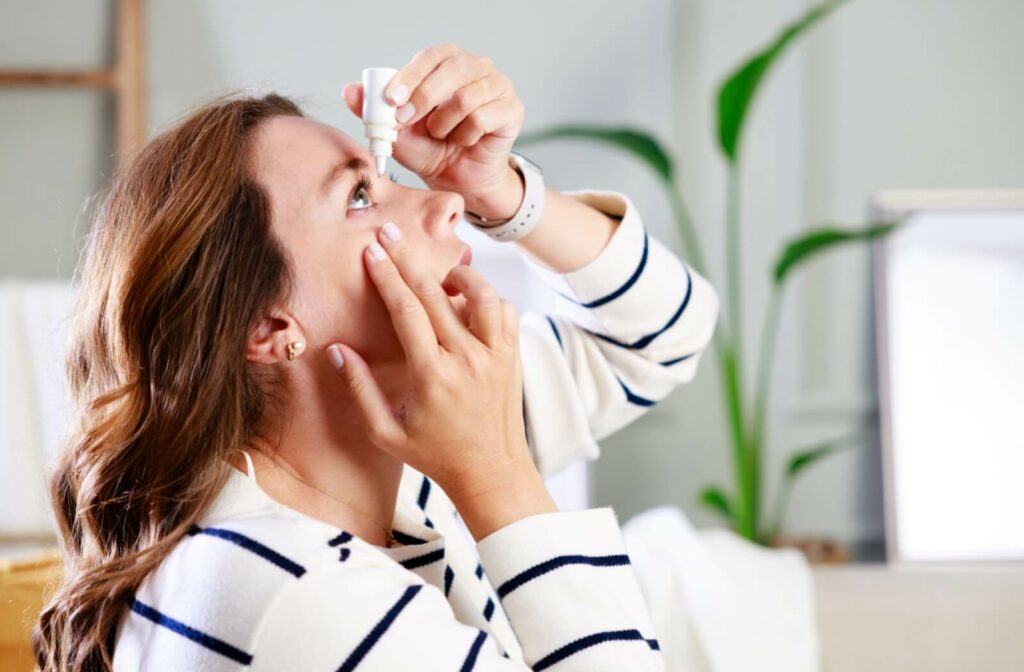Do you wear contact lenses and find your eyes feel dry or irritated by midday? You’re not alone! Whether it’s dryness, irritation, or the constant urge to blink, these issues often leave you questioning whether contacts are worth the hassle.
The good news? There are clear reasons behind these problems and practical solutions to help you wear your lenses comfortably again. Common causes include:
- Reduced tear production
- Poor fit or material of contact lenses
- Environmental factors
- Prolonged screen time
Remedies can include switching your type of contact lenses, using dry eye drops, and more. Read along as we explore each of these causes and remedies to help you find real relief.
Dry Eyes & Contact Lens Discomfort
Dry eyes occur when the eyes don’t produce enough or the right kind of tears to keep the surface properly lubricated. Contact lenses can sometimes intensify this issue—after all, they sit directly on the tear film, the protective layer over the eyes.
When your tears are insufficient, contact lenses can feel dry, sticky, or uncomfortable. This can lead to:
- Redness
- Blurred vision
- Burning sensation
But don’t toss out your lenses just yet—understanding the root causes of dry eyes is key to finding relief.
Common Causes of Dry Eyes for Contact Lens Wearers
Several factors contribute to dry eyes for contact lens wearers. Pinpointing the cause is the first step toward resolving discomfort.
- Reduced Tear Production
Sometimes, your eyes just don’t make enough tears. This can naturally happen as you age or due to certain conditions like Sjögren’s syndrome.
- Poor Fit or Material of Contact Lenses
Every pair of eyes is different, and so are contact lenses. An ill-fitting lens or one made from less breathable materials may prevent proper oxygen flow to your eyes, leading to dryness.
- Environmental Factors That Dry Out Your Eyes
Dry climates, air conditioning, and wind aren’t just annoying—they can strip the moisture from your eyes. Your contact lenses may feel like sandpaper if you’re constantly exposed to these conditions.
- Prolonged Screen Time & Its Impact on Tears
We all blink less when staring at screens, and this reduced blinking disrupts the tear film. Add contacts to the mix, and you’ve got a recipe for dry, irritated eyes by the end of your workday.
Remedies for Managing Dry Eyes While Wearing Contacts

If dry eyes are making your contacts uncomfortable, there’s good news—solutions are plentiful. Here are some remedies to help you achieve all-day comfort.
- Choosing the Right Contact Lens Solution
Not all lens solutions are created equal. Some contain harsher preservatives that can intensify dryness. Opt for solutions specifically designed to be gentle and hydrating.
- Switching to Lenses Designed for Dry Eyes
Consider switching to silicone hydrogel lenses or daily disposable lenses. These materials are designed to retain moisture better and allow more oxygen to reach your eyes.
- Using Rewetting Drops Safe for Contacts
Over-the-counter rewetting drops can work wonders for dry eyes, but make sure the ones you choose are labeled as safe for contact lenses.
- Lifestyle Changes to Improve Contact Lens Comfort
Making certain lifestyle changes can help improve eye discomfort naturally. These include:
- Staying Hydrated: Dehydration can affect tear production, so drink up! Aim for at least 8 glasses of water a day to keep your body (and eyes) hydrated.
- Adding a Humidifier to Your Space: Fight back against dry air at home or work by using a humidifier. Your eyes—and your skin—will thank you.
- Taking Regular Breaks from Screens: Practice the 20-20-20 rule to reduce screen strain. Every 20 minutes, look at something 20 feet away for 20 seconds to help naturally refresh your tear film.
Medical Treatments for Persistent Dry Eyes
If the above remedies aren’t cutting it, it may be time to seek treatment from an eye care professional. Common options include:
BlephEx
This is a specialized treatment that involves a thorough cleaning of the eyelid margins. It’s particularly beneficial for those suffering from blepharitis, a common eyelid inflammation, as it helps reduce irritation and promotes healthier tear production, leading to more comfortable eyes.
Xiidra & Restasis
These are prescription eye drops designed to manage the symptoms of chronic dry eyes, a condition that affects many people.
- Xiidra works by blocking certain proteins that contribute to inflammation
- Restasis helps increase the eyes’ natural ability to produce tears by reducing inflammation
Together, they offer significant relief by improving overall tear production and providing long-term benefits for those struggling with dry eyes.
Punctal Plugs
These tiny, biocompatible plugs are gently inserted into your tear ducts. By blocking the drainage of tears, they help retain moisture in your eyes for a longer period.
This method is particularly useful for people with severe dry eye symptoms, providing them with the moisture retention they need to keep their eyes comfortable and hydrated throughout the day.
Preventing Dry Eyes & Ensuring Long-Term Comfort
Prevention is always better than cure. To ensure your eyes stay comfortable in the long run, invest in high-quality lenses, follow best practices for lens care, and stay proactive about addressing signs of dryness before they escalate.
If you’re dealing with persistent contact lens discomfort or dry eyes, book an appointment with Advance Eye Care Center.
Whether you’re changing your lenses, tweaking your care routine, or exploring treatments like BlephEx or Restasis, the right guidance can help you regain your love for your lenses.





